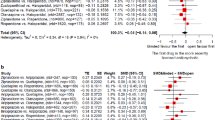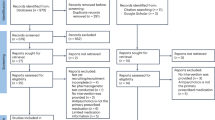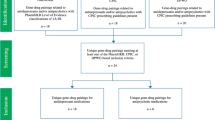Abstract
This study presents a meta-analysis of the influence of several potentially biasing factors (eg industry support, extrapyramidal side effects) on efficacy of studies comparing second-generation antipsychotic (SGA) with first-generation antipsychotic (FGA) medications. We used the dataset from our previously published meta-analysis of 124 randomized controlled trials (RCTs) comparing SGAs with FGAs, to evaluate whether certain possible biases could influence the actual outcome on the total score of the Positive and Negative Syndrome Scale (PANSS), Brief Psychiatric Rating Scale (BPRS), and Clinical Global Impressions (CGI) scores. Industry sponsorship was determined by contact with authors or publication statement. We calculated whether (1) industry sponsorship, (2) study quality, (3) extrapyramidal symptoms (EPS) properties, or (4) prophylactic antiparkinsonian medications influenced SGA vs FGA efficacy for each drug and averaged overall by two Hedges and Olkin-based meta-analyses. The analysis found that none of the factors was significantly associated with a particular outcome. While industry-sponsored articles may conclude their medication to be more favorable than that of a competitor in an RCT, we found that the observed efficacy was not influenced by sponsorship. Many attribute the finding that SGAs appears to be more efficacious than FGAs to be a result of EPS-decreasing efficacy (or its measurement). We were unable to confirm that the drug's EPS properties or antiparkinsonian management altered actual efficacy.
Similar content being viewed by others
Log in or create a free account to read this content
Gain free access to this article, as well as selected content from this journal and more on nature.com
or
References
Bodenheimer T (2000). Uneasy alliance—clinical investigators and the pharmaceutical industry (see comment). N Engl J Med 342: 1539–1544.
Borenstein M, Hedges L, Higgins J, Rothstein H (2005). Comprehensive Meta-Analysis, version 2. Biostat: Englewood, NJ.
Buchanan RW, Breier A, Kirkpatrick B, Ball P, Carpenter WT (1998). Positive and negative symptom response to clozapine in schizophrenic patients with and without the deficit syndrome. Am J Psychiatry 155: 751–760.
Conley RR, Mahmoud R (2001). A randomized double-blind study of risperidone and olanzapine in the treatment of schizophrenia or schizoaffective disorder. Am J Psychiatry 158: 765–774.
Davis JM, Chen N (2001). The effects of olanzapine on the 5 dimensions of schizophrenia derived by factor analysis: combined results of the North American and international trials. J Clin Psychiatry 62: 757–771.
Davis JM, Chen N (2002). Clinical profile of an atypical antipsychotic: risperidone. Schizophr Bull 28: 43–61.
Davis JM, Chen N (2004). Dose-response and dose equivalence of antipsychotics. J Clin Psychopharmacol 24: 192–208.
Davis JM, Chen N, Glick ID (2003). A meta-analysis of the efficacy of second-generation antipsychotics. Arch Gen Psychiatry 60: 553–564.
Geddes J, Freemantle N, Harrison P, Bebbington P (2000). The National Schizophrenia Guideline Development Group. Atypical antipsychotics in the treatment of schizophrenia systematic overview and meta-regression analysis. Br Med J 321: 1371–1376.
Guy W (1976). Clinical Global Impressions (CGI). ECDEU Assessment Manual for Psychopharmacology. In: US Department of Health, Education, and Welfare publication (ADM) 76-338. National Institute of Mental Health: Rockville MD, pp 218–222.
Hedges LV, Olkin I (1985). Statistical Methods for Meta-Analysis. Academic Press: Orlando, FL.
Heres S, Davis JM, Maino K, Jetzinger E, Kissling W, Leucht S (2006). Why olanzapine beats risperidone, risperidone beats quetiapine and quetiapine beats olanzapine again: an analysis of head-to-head studies on second-generation antipsychotics. Am J Psychiatry 163: 185–194.
Kane J, Honigfeld G, Singer J, Meltzer H (1988). Clozapine for the treatment-resistant schizophrenic: a double-blind comparison with chlorpromazine. The Clozaril Collaborative Study Group. Arch Gen Psychiatry 45: 789–796.
Kay SR, Fiszbein A, Opler LA (1987). The positive and negative syndrome scale (PANSS) for schizophrenia. Schizophr Bull 13: 261–276.
Klein DF, Davis JM (1969). Diagnosis and Drug Treatment of Psychiatric Disorders. Williams & Wilkins: Baltimore, MD.
Lieberman JA, Stroup TS, McEvoy JP, Swartz MS, Rosenheck RA, Perkins DO et al (2005). Clinical Antipsychotic Trials of Intervention Effectiveness (CATIE) investigators. Effectiveness of antipsychotic drugs in patients with chronic schizophrenia. N Engl J Med 353: 1209–1223.
Marder SR, Davis JM, Chouinard G (1997). The effects of risperidone on the five dimensions of schizophrenia derived by factor analysis: combined results of the North American trials (erratum appears in J Clin Psychiatry 1998;59(4):200). J Clin Psychiatry 58: 538–546.
Montgomery JH, Byerly M, Carmody T, Li B, Miller DR, Varghese F et al (2004). An analysis of the effect of funding source in randomized clinical trials of second generation antipsychotics for the treatment of schizophrenia. Control Clin Trials 25: 598–612.
Overall J, Gorham D (1962). The Brief Psychiatric Rating Scale. Psychol Rep 10: 799–812.
Rosenberg MS, Adams DC, Gureveitch J (2000). MetaWin: Statistical Software for Meta-Analysis, Version 2.0 edition. Sinauer Associates: Sunderland, MA.
Rosenheck RA (2005). Open forum: effectiveness versus efficacy of second-generation antipsychotics: haloperidol without anticholinergics as a comparator. Psychiatr Serv 56: 85–92.
Wang MC, Bushman BJ (1999). Integrating Results Through Meta-Analytic Review Using SAS Software. SAS Institute Inc: Cary, NC.
Acknowledgements
This study was supported in part by National Institute of Mental Health Grant No. 1 P01MH68580-01 CFDA #93.242.
Author information
Authors and Affiliations
Corresponding author
Additional information
DISCLOSURE/CONFLICT OF INTEREST
John Davis and Nancy Chen have no financial conflict of interest and have not received or anticipate receiving any monetary support from the pharmaceutical industry including compensation for professional services, research support, honorarium, speaker's fees, royalties, stock or stock options, consultantship and reimbursement for travel expenses, over the past 5 years. Ira Glick, over the past 5 years, either has served on advisory boards, received research support, or been on speakers’ bureaus for Solvay, Shire, Glaxo, Janssen, Lilly, AstraZeneca, Pfizer, BMS-Otsuka, and the NIMH. Dr Glick also has stock in Johnson & Johnson and Forrest Laboratories.
Rights and permissions
About this article
Cite this article
Davis, J., Chen, N. & Glick, I. Issues that May Determine the Outcome of Antipsychotic Trials: Industry Sponsorship and Extrapyramidal Side Effect. Neuropsychopharmacol 33, 971–975 (2008). https://doi.org/10.1038/sj.npp.1301493
Received:
Revised:
Accepted:
Published:
Issue date:
DOI: https://doi.org/10.1038/sj.npp.1301493
Keywords
This article is cited by
-
The association of funding source on effect size in randomized controlled trials: 2013–2015 – a cross-sectional survey and meta-analysis
Trials (2017)
-
Colonic architectural change on colonoscopy in patients taking psychotropic medications
Surgical Endoscopy (2013)
-
Conflict of Interest, Journal Review, and Publication Policy
Neuropsychopharmacology (2008)



